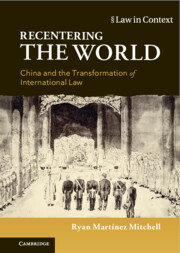Book contents
- Recentering the World
- Law in Context
- Recentering the World
- Copyright page
- Epigraph
- Contents
- Acknowledgments
- Archives and Databases Consulted
- Treaties, Agreements, and Legislation
- Cases
- Introduction
- Part I Preserving Stateliness, 1850–1894
- Part II Asserting Sovereignty, 1895–1921
- 4 The Public Law of Planet Earth
- 5 The Problem of Equality
- 6 Reconstituted Hierarchies
- Part III Internationalisms, 1922–2001
- Glossary of Chinese and Japanese Names
- Notes
- Bibliography
- Index
5 - The Problem of Equality
from Part II - Asserting Sovereignty, 1895–1921
Published online by Cambridge University Press: 27 October 2022
- Recentering the World
- Law in Context
- Recentering the World
- Copyright page
- Epigraph
- Contents
- Acknowledgments
- Archives and Databases Consulted
- Treaties, Agreements, and Legislation
- Cases
- Introduction
- Part I Preserving Stateliness, 1850–1894
- Part II Asserting Sovereignty, 1895–1921
- 4 The Public Law of Planet Earth
- 5 The Problem of Equality
- 6 Reconstituted Hierarchies
- Part III Internationalisms, 1922–2001
- Glossary of Chinese and Japanese Names
- Notes
- Bibliography
- Index
Summary
The final discrediting of the Manchu regime’s traditionalism sparked a range of new efforts in domestic and also foreign policy, and fostered an embrace of international law as a vocabulary for the articulation of state interests and “rights” that would continually intensify across successive governments. From this point forward, Chinese positions on public law issues at the international and domestic levels would be closely related. This phenomenon was perhaps most strikingly illustrated in the often-overlooked but crucial Chinese role at the Second Hague Conference of 1907, where for the first time China’s delegates joined other marginalized states of the “Global South” to resist initiatives by great powers.
- Type
- Chapter
- Information
- Recentering the WorldChina and the Transformation of International Law, pp. 98 - 120Publisher: Cambridge University PressPrint publication year: 2022

